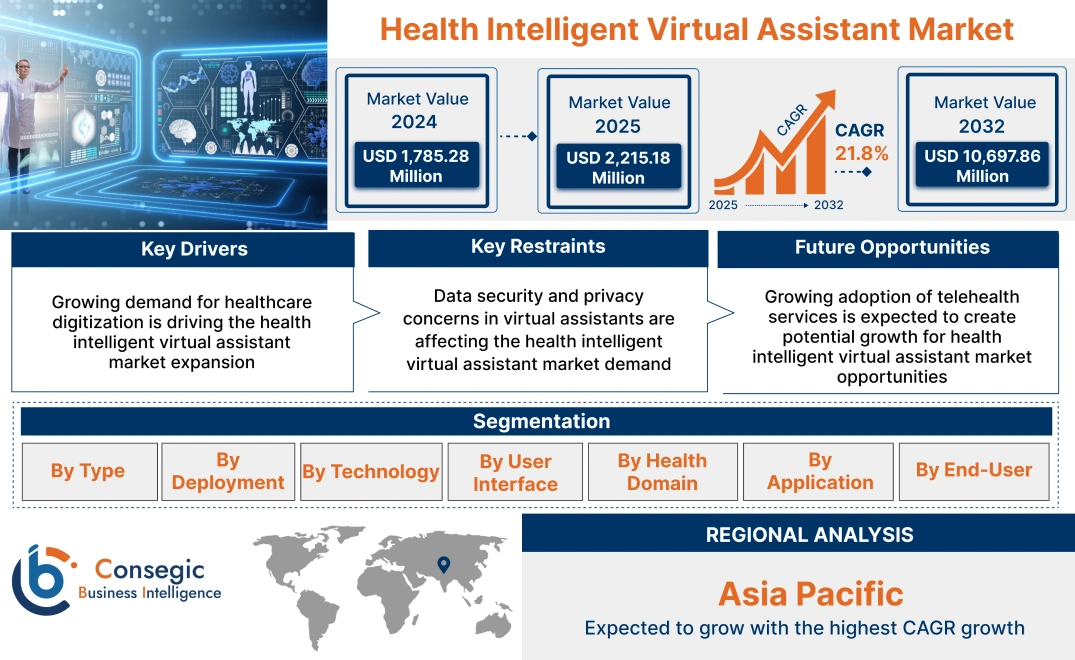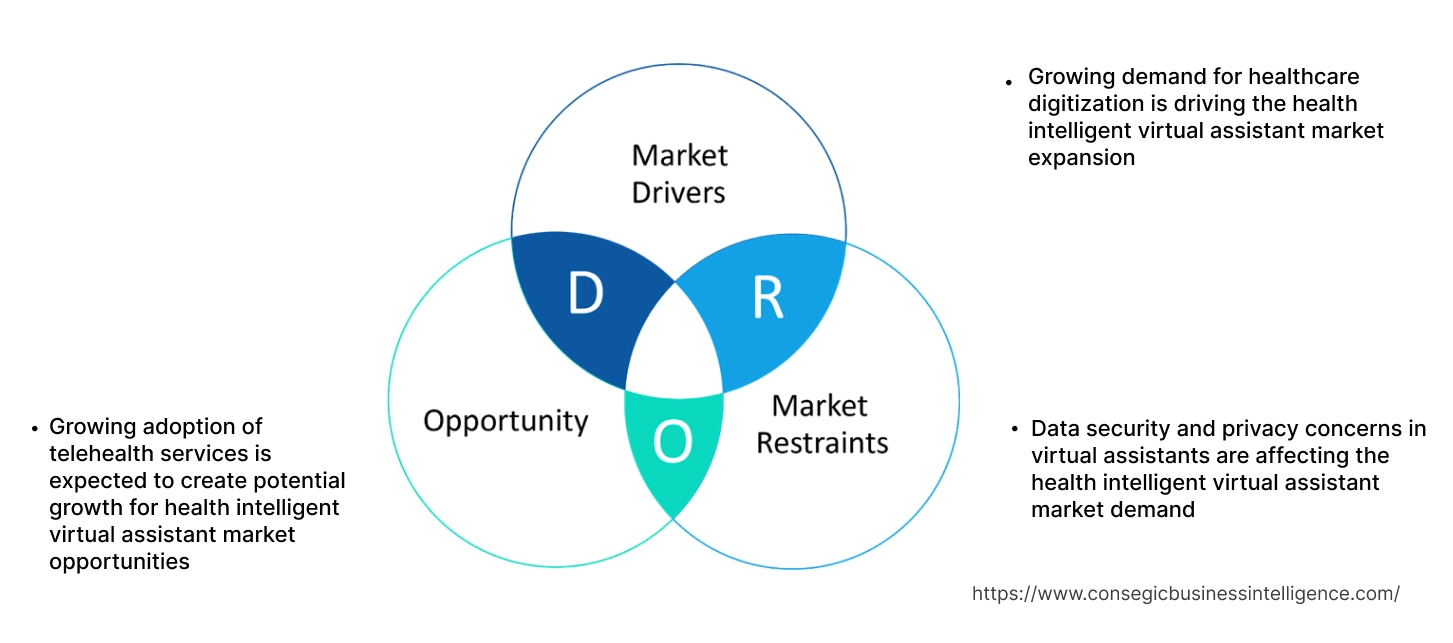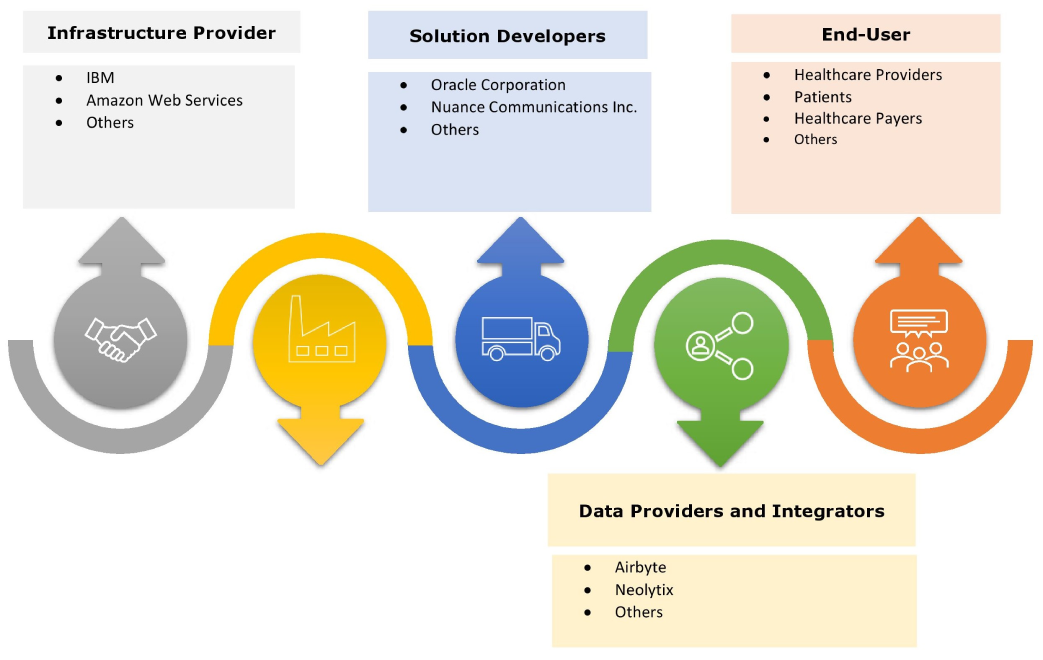- Summary
- Table Of Content
- Methodology
Health Intelligent Virtual Assistant Market Size:
Health Intelligent Virtual Assistant Market Size is estimated to reach over USD 10,697.86 Million by 2032 from a value of USD 1,785.28 Million in 2024 and is projected to grow by USD 2,215.18 Million in 2025, growing at a CAGR of 21.8% from 2025 to 2032.
Health Intelligent Virtual Assistant Market Scope & Overview:
The use of virtual assistance in healthcare can be characterized as providing medical-related services via remote monitoring and connecting with patients through virtual means. These virtual assistant services encompass engaging with patients at home, analyzing symptoms with mobile applications, and obtaining disease information using smart speakers. Various types of virtual assistant products exist, such as smart speakers, online chatbots, and mobile chatbots. Further, the incorporation of cutting-edge technologies like natural language processing (NLP) and machine learning (ML) is driving innovation in the health intelligent virtual assistant market. These technologies allow IVAs to comprehend and react to natural language inquiries, adapt from user interactions, and enhance their performance progressively. Consequently, IVAs are evolving to be more advanced, providing increasingly tailored and context-sensitive healthcare assistance, which propels further growth and acceptance of the market.
Key Drivers:
Growing demand for healthcare digitization is driving the health intelligent virtual assistant market expansion
The healthcare sector is steadily adopting digital technologies to improve service delivery, with virtual assistants at the forefront of this transformation. As healthcare systems shift towards digital solutions, virtual assistants support the management of administrative responsibilities, streamline processes, and enhance service efficiency. This transition to digitalization enables healthcare providers to offer more accessible and timely care to patients, especially in remote areas. Furthermore, virtual assistants help healthcare organizations in managing patient records, organizing appointments, and distributing health information, thus reducing human errors and enhancing workflow. As healthcare providers continue to invest in digital health technologies to refine their operations, the demand for AI-powered virtual assistants will grow, as they provide a cost-effective and scalable solution to address the increasing needs of the industry.
- For instance, in July 2024, DocVA launched an all-encompassing range of virtual medical assistant services, transforming healthcare functions. Drawing on extensive industry experience, the organization seeks to optimize medical operations by providing proficient remote assistants for both administrative and clinical support roles.
Thus, according to the health intelligent virtual assistant market analysis, the growing adoption of digitization in the healthcare sector is driving the health intelligent virtual assistant market size and trends.
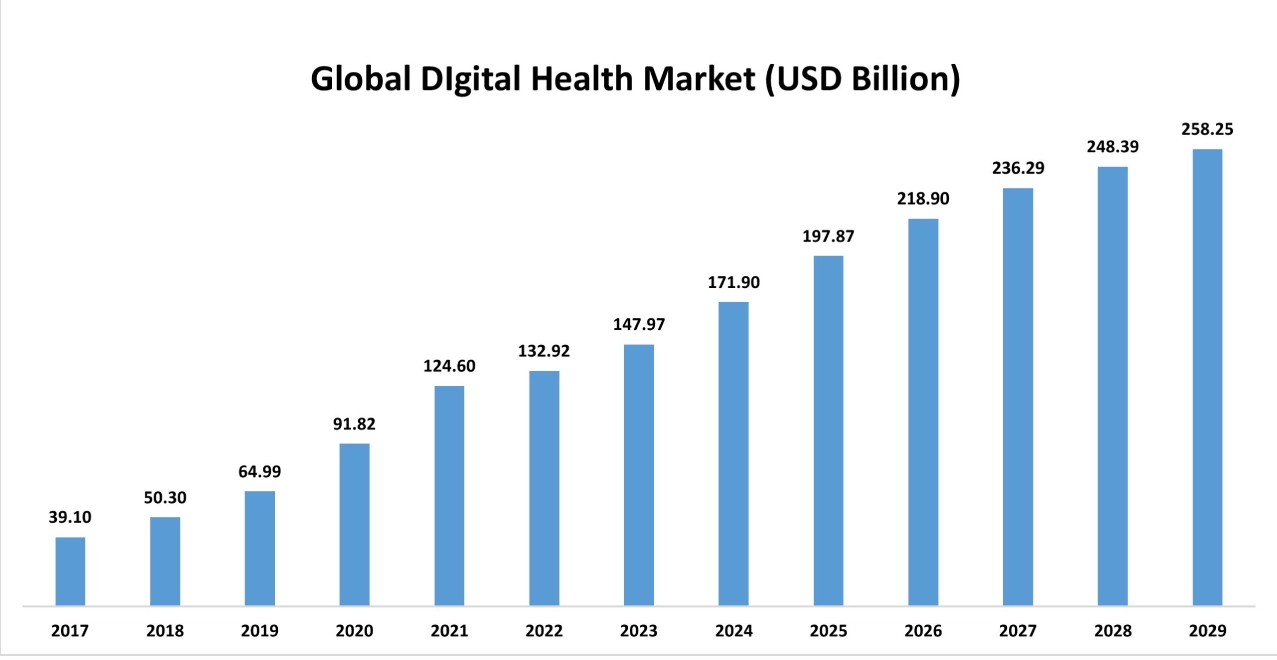
Key Restraints:
Data security and privacy concerns in virtual assistants are affecting the health intelligent virtual assistant market demand
Since virtual assistants handle sensitive health data, they are required to adhere to stringent regulations such as HIPAA in the U.S. and GDPR in Europe. These systems frequently utilize cloud computing and AI technologies to manage and store substantial volumes of personal information, heightening the risk of cyber threats, data breaches, and unauthorized access. Healthcare providers must adopt strong cybersecurity strategies, including encryption and secure data storage solutions, to safeguard patient privacy. Additionally, patients may feel hesitant to disclose their private health information to AI-driven systems, which could impede acceptance. Ensuring compliance with privacy regulations and maintaining transparency about data usage are vital for addressing these issues, yet they continue to pose a considerable challenge for the market's growth. These factors would have a further impact on the market during the forecast period.
Future Opportunities :
Growing adoption of telehealth services is expected to create potential growth for health intelligent virtual assistant market opportunities
Telehealth has become an essential tool for providing healthcare services from a distance, particularly in light of the COVID-19 pandemic, where social distancing was necessary. Intelligent virtual assistants significantly contribute to this framework by delivering tailored and responsive support to both healthcare professionals and patients. These assistants utilize cutting-edge technologies like artificial intelligence and natural language processing to provide immediate assistance, manage appointment scheduling, offer medication reminders, and even deliver basic medical guidance. The incorporation of intelligent virtual assistants into telehealth systems improves the overall efficiency and effectiveness of healthcare services. These assistants can simplify administrative duties, enabling healthcare providers to concentrate more on patient care. By automating routine tasks and enhancing communication between patients and providers, intelligent virtual assistants aid in better resource utilization and cost reductions within the healthcare sector. With the increasing demand for telehealth, driven by technological advancements and changing patient preferences, the global market is set for further growth in the years ahead.
- For instance, in April 2022, Real Chemistry announced the acquisition of ConversationHealth.com. This acquisition enables Real Chemistry to integrate high-quality conversational AI technologies and medical knowledge into its offerings. As a result, Real Chemistry's clients can provide medical communications on a vast scale, leveraging multiple channels, including text, voice, and digital avatars, across various markets and languages.
Thus, based on the above analysis, the growing adoption of intelligent virtual assistants in medical applications is driving the health intelligent virtual assistant market opportunities and trends.
Health Intelligent Virtual Assistant Market Segmental Analysis :
By Type:
Based on type, the health intelligent virtual assistant market is segmented into web-based and mobile-based.
Trends in the type:
- The increasing worldwide population and the escalating occurrence of chronic illnesses are fuelling the need for healthcare services, placing stress on healthcare systems.
- Healthcare practitioners are looking for strategies to enhance patient involvement, lessen administrative challenges, and streamline processes.
- The swift advancement of AI and machine learning technologies is facilitating the development of more advanced and efficient HIVAs.
- Thus, factors such as increasing need for healthcare services would further create the health intelligent virtual assistant market demand and opportunities during the forecast period.
The web-based segment accounted for the largest revenue share in the year 2024.
- The rising inclination towards remote healthcare options, influenced by elements such as ease of access and affordability, is propelling the use of online virtual assistants.
- Natural Language Processing (NLP) technologies are allowing web-based HIVAs to comprehend and reply to user inquiries in a more intuitive and dialogue-like fashion.
- For instance, in May 2021, Microsoft has launched its Azure Health Bot service in West U.S. 2, East U.S. 2, South Central U.S., UK South, North Europe, Southeast Asia, Australia East, and India Central with newly added languages. This approach will assist the company in enhancing its customer base and expanding its market share.
- Through offering tailored information and assistance, web-based HIVAs enable patients to take an active role in their healthcare experience.
- The factors and developments are shaping the future of health intelligent virtual assistant market growth.
The mobile-based segment is anticipated to register the fastest CAGR during the forecast period.
- Patients are looking for customized healthcare experiences, and mobile-based virtual assistants can provide individualized assistance and information.
- Mobile-based virtual assistants are essential in handling chronic illnesses by offering medication reminders, monitoring symptoms, and delivering personalized support.
- Thus factors, such as growing need for personalised healthcare and need for cost-effective healthcare solutions would further drive the health intelligent virtual assistant market size during the forecast period.
By Deployment:
Based on deployment, the market is segmented into on-premises, cloud, and hybrid.
Trends in deployment:
- Cloud platforms provide scalability, adaptability, and economic viability, rendering them a favoured option for implementing HIVAs. This facilitates convenient access, updates, and integration with various healthcare systems.
- For entities with rigorous data security standards, on-premises deployment offers enhanced oversight of data management and accessibility. This method is frequently favoured for dealing with confidential patient information.
- Integrating cloud and on-premises deployment strategies enables organizations to harness the advantages of both. This strategy can involve keeping sensitive data on-premises while employing cloud resources for additional functions.
- These factors in the deployment segment would further drive the global market during the forecast period.
The on-premises segment accounted for the largest revenue share of 56.78% in the year 2024.
- On-site implementations offer enhanced management of sensitive patient information, lowering the chances of unauthorized access or security incidents. This aspect is vital for healthcare institutions dealing with extremely confidential data.
- On-site implementations can be more seamlessly incorporated with current legacy systems, which might not work well with cloud-based options.
- The factors and developments, such as enhanced data security and improved compliance are driving the future of health intelligent virtual assistant market growth.
The cloud segment is anticipated to register the fastest CAGR during the forecast period.
- Cloud platforms allow for easy scaling of virtual assistants based on demand, ensuring optimal performance even during peak usage periods. This flexibility is crucial for healthcare organizations with fluctuating patient volumes.
- Cloud-based HIVAs can be accessed from any device with an internet connection, providing convenient and on-demand support for patients and healthcare professionals.
- Cloud-based implementations remove the requirement for substantial initial expenditures on hardware and infrastructure, increasing the accessibility of HIVA technology for healthcare institutions of any size.
- For instance, in November 2022, North Hertfordshire (NHS) Trust and East introduced Enquire, a smart virtual assistant powered by IBM Watson Assistant on IBM Cloud. This project seeks to support the trust's HR team in handling inquiries from its 6,500 employees. The platform has been developed for the NHS Trust to alleviate the administrative load on HR personnel, enabling them to concentrate on more intricate and impactful responsibilities.
- These factors and analysis in the cloud deployment would further drive the market growth during the forecast period.
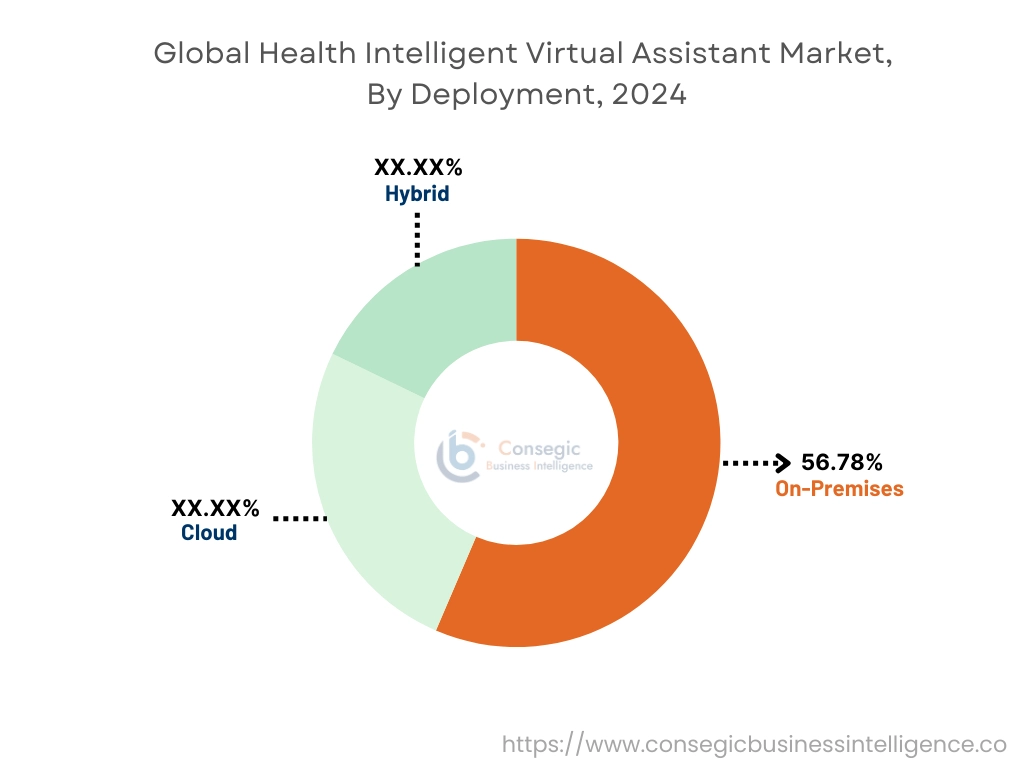
By Technology:
Based on technology, the market is segmented into natural language processing, machine Learning, and deep Learning source.
Trends in technology:
- NLP allows virtual assistants to comprehend and reply to human language in a fluid and conversational way, enhancing user experience and interaction.
- Voice technology facilitates hands-free communication with HIVAs, increasing their accessibility and convenience for patients and healthcare providers.
- Healthcare organizations are focusing on patient engagement to enhance outcomes and satisfaction. Virtual assistants enable patients to take an active role in their own care.
- These developments would further supplement the health intelligent virtual assistant market trends during the forecast period.
The natural language processing segment accounted for the largest revenue share in the year 2024 and it is expected to register the highest CAGR during the forecast period.
- Health intelligent virtual assistants powered by NLP are progressively providing multilingual features, dismantling language obstacles and enhancing healthcare access for varied communities.
- NLP can evaluate the emotional nuances of user engagements, enabling health intelligent virtual assistants to deliver more compassionate and tailored assistance.
- The integration of NLP with voice identification and generation facilitates hands-free communication with virtual, improving convenience and accessibility.
- These factors and analysis in the natural language processing technology segment would further drive the health intelligent virtual assistant market during the forecast period.
By User Interface:
Based on user interface, the market is segmented into automatic speech recognition, text to speech, and text based.
Trends in user interface:
- Healthcare virtual assistants are progressively embracing conversational interfaces, enabling users to communicate with them in natural language, whether via text or voice.
- Virtual assistant’s user interfaces are evolving to be more customized, adjusting the information and assistance offered to suit each user's specific needs and likes.
- These analysis and factors, such as growing need for conversational interfaces and personalization would further drive the health intelligent virtual assistant market share during the forecast period.
The automatic speech recognition segment accounted for the largest revenue in the year 2024 and it is expected to register the highest CAGR during the forecast period.
- Automatic Speech Recognition (ASR) emerges as a key technology area within the industry. ASR empowers virtual assistants to comprehend and decode spoken words, facilitating user interactions with healthcare systems via voice commands. This technology proves especially beneficial in situations where hands-free functionality is crucial, such as during medical operations or when retrieving patient records.
- The rising need for hands-free, effective, and precise communication in healthcare environments is fuelling this expansion. ASR technology enables healthcare workers and patients to engage with virtual assistants using everyday spoken language, minimizing the requirement for manual entry and improving overall workflow productivity.
- For instance, Nuance healthcare development platform offers SDKs to match the needs and priorities of healthcare clients with advanced voice and language technologies. The platform’s speech recognition hosting is supported by Microsoft Azure, that provides a comprehensive and flexible framework of prescriptive and scalable security controls to mitigate risks.
- These factors and trends, such as growing need for ASR technology in medical virtual assistants driving the health intelligent virtual assistant market trends during the forecast period.
By Health Domain:
Based on health domain, the market is segmented into chronic disease management, mental health care, nutrition wellness, telemedicine, and primary care.
Trends in health domain:
- The virtual healthcare assistants are utilized to deliver customized health suggestions, monitor vital statistics, and supply personalized assistance for handling chronic illnesses.
- Virtual assistants are becoming more essential in delivering mental health assistance, presenting discreet and readily available resources for people facing anxiety, depression, or stress.
- The rising occurrence of chronic illnesses is fuelling the need for efficient management strategies, and health intelligent virtual assistants can significantly contribute by offering tailored support and education.
- These factors would further drive the health intelligent virtual assistant market share during the forecast period.
The chronic disease management segment accounted for the largest revenue in the year 2024.
- Patients with long-term health issues frequently face challenges in sticking to treatment regimens and making necessary lifestyle changes. HIVAs can boost patient involvement by delivering ongoing support and encouragement.
- Healthcare systems are moving towards care models that emphasize value, focusing on results and cost efficiency.
- Health intelligent virtual assistants can contribute to better patient results and lower healthcare expenses by fostering proactive management and averting complications.
- Virtual assistants can also assist with mental health issues, including depression and anxiety, by offering coping techniques, mindfulness practices, and facilitating connections with mental health specialists.
- Thus, factors such as growing need for personalised and remote monitoring driving the global market trends during the forecast period.
The telemedicine segment is anticipated to register the fastest CAGR during the forecast period.
- The growing implementation of telemedicine by healthcare providers, alongside heightened patient acceptance and consumer interest, as well as the provision of enhanced care quality, is anticipated to fuel the development of the telemedicine sector throughout the projected period.
- The rise in remote healthcare delivery, covering acute care, along with advancements in fields like radiology, cardiology, and behavioural health, has led to the creation of new business and healthcare frameworks linked to telehealth.
- In recent years, AI-driven kiosks have appeared in local shopping centers. This system features a smart medicine cabinet capable of dispensing over 100 different medications. Moreover, AI provides a groundbreaking method to improve medical diagnoses by facilitating quicker diagnosis times than those achieved by healthcare professionals.
- For instance, in September 2023, the Indian Ministry of Health and Family Welfare announced that it had approved the Department of Telemedicine at PGI as a center of excellence in telepathology for India. Telepathology can be used for remotely rendering primary diagnosis, quality assurance, second opinion consultations, and research purposes.
- These factors and developments in the telemedicine segment would further drive the global market trends during the forecast period.
By Application:
Based on application, the market is segmented into patient engagement administrative assistance, symptom checking, and telehealth support.
Trends in application:
- Virtual assistants deliver tailored health information to patients, respond to their queries, and give assistance in managing their health issues. They are also capable of sending notifications for appointments, medications, and preventive check-ups.
- Healthcare virtual assistants facilitate the scheduling of appointments, dispatch reminders, and oversee cancellations, lessening administrative workload and enhancing patient access to healthcare.
- These factors and developments in the application segment would further drive the global market share and trends during the forecast period.
The patient engagement segment accounted for the largest revenue in the year 2024 and it is expected to register the highest CAGR during the forecast period.
- Healthcare institutions are progressively emphasizing patient-centered care, and virtual assistants enable patients to take an active role in their healthcare experience.
- The extensive use of smartphones and mobile gadgets offers a practical avenue for patients to engage with HIVAs.
- For instance, in October 2022, AtlantiCare partnered with Orbita, Inc., a provider of virtual assistant and conversational AI solutions. The healthcare organization has effectively integrated Orbita's virtual assistant and AI platform, facilitating smooth interaction between individuals and their healthcare professionals. With this technology, AtlantiCare seeks to improve patient access to self-scheduling features while maintaining a user-friendly experience.
- These factors and developments in the would further drive the global market trends during the forecast period.
By End User:
Based on the end user, the market is segmented into healthcare providers, patients, healthcare payers, and others.
Trends in the end user:
- Healthcare professionals are searching for methods to optimize workflows and lessen administrative strain, and virtual assistants can facilitate task automation and enhance efficiency.
- Insurers are aiming to lower healthcare expenses, and HIVAs can assist by boosting patient compliance, avoiding hospital readmissions, and encouraging preventive care.
- By emphasizing patient-centered care, enhancing efficiency, and tackling issues surrounding trust and privacy, healthcare institutions can utilize virtual assistants to revolutionize the healthcare experience for all parties involved.
The healthcare providers segment accounted for the largest revenue in the year 2024 and it is expected to register the highest CAGR during the forecast period.
- They assist with a range of services including arranging and verifying appointments, sending appointment reminders, checking in with patients, and offering medical evaluations alongside physicians.
- The rising implementation of electronic health records (EHRs) and the necessity for smooth integration of healthcare systems have fuelled the need for health intelligent virtual assistants (IVAs) within the provider sector.
- Intelligent virtual assistants are capable of connecting with current EHR systems and obtaining patient data, allowing healthcare professionals to swiftly access pertinent information and make well-informed choices during patient meetings.
- These trends and factors are anticipated to further drive the global market during the forecast period.
Regional Analysis:
The global market has been classified by region into North America, Europe, Asia-Pacific, MEA, and Latin America.
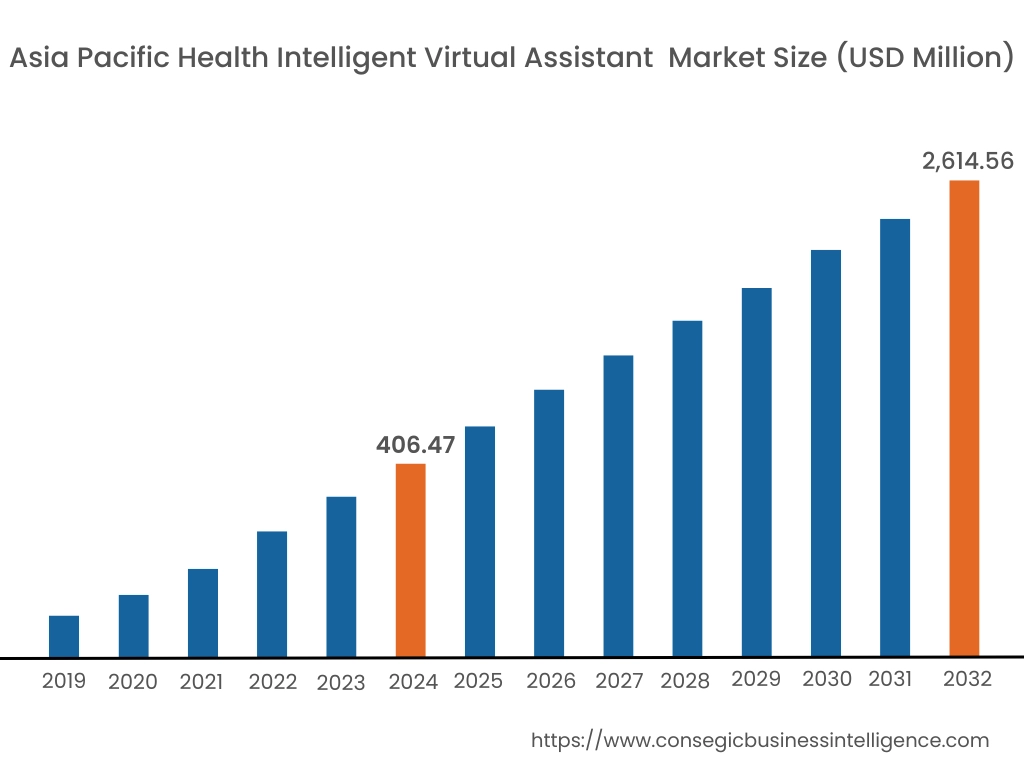
Asia Pacific health intelligent virtual assistant market expansion is estimated to reach over USD 2,614.56 million by 2032 from a value of USD 406.47 million in 2024 and is projected to grow by USD 507.44 million in 2025. Out of this, the China market accounted for the maximum revenue split of 33.48%. Countries such as China, India, and Japan are witnessing a notable increase in the need for smart virtual assistants in the healthcare sector to meet the rising healthcare requirements of their citizens. The government of India has acknowledged the promise of Digital Health in enhancing the healthcare delivery framework throughout the nation. Several programs and initiatives have been launched by the government of India to execute digital health projects. For instance, the Ayushman Bharat Digital Mission (ABDM) has been established to create a supportive environment for the adoption of digital health technologies in the healthcare sector. As part of the ABDM, three primary registries, including Health ID, Health Professional Registry (HPR), Health Facility Registry (HFR), along with digital infrastructure for data sharing, have been established. The implementation of these technologies will enable the Asian market to develop effectively by improving patient involvement. These factors would further drive the regional market during the forecast period.
- For instance, in May 2024, Fortis Healthcare announced the collaboration with United We Care to introduce Adayu Mindfulness, an AI-driven mental health platform that provides round-the-clock virtual support and self-evaluation resources. The platform will provide telemental health services, alongside residential in-patient care that covers acute psychiatry, rehabilitation, and addiction treatment.
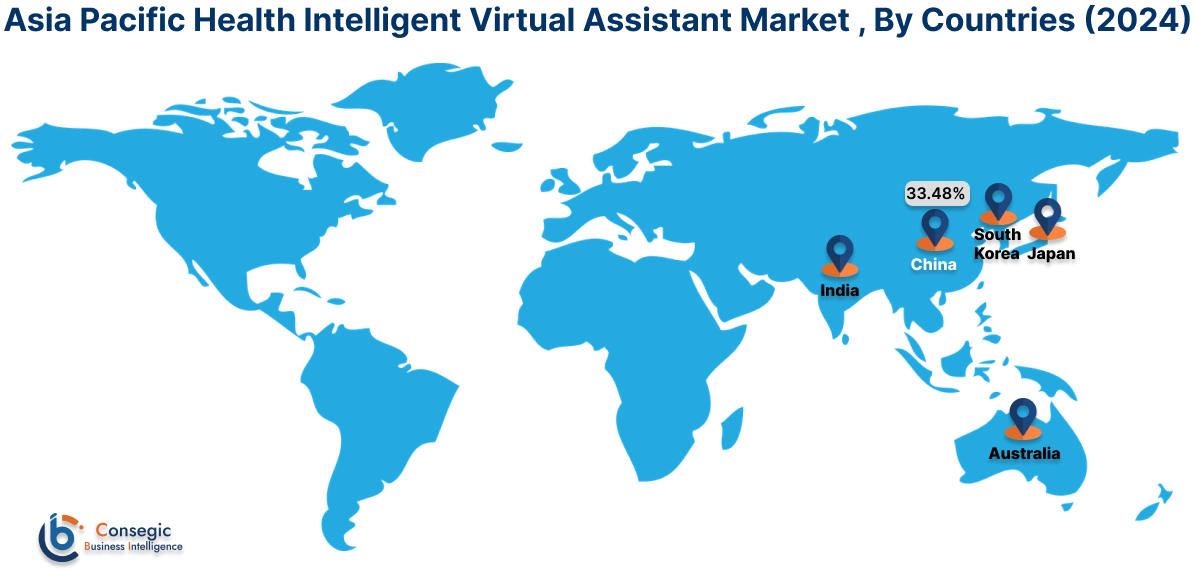
North America market is estimated to reach over USD 4,065.19 million by 2032 from a value of USD 683.21 million in 2024 and is projected to grow by USD 847.23 million in 2025. The regional dominance is mainly influenced by the widespread adoption of cutting-edge technologies, such as AI and voice-controlled systems, within healthcare facilities in the United States and Canada. The robust healthcare infrastructure in this region, along with a rising need for patient engagement solutions and operational effectiveness, plays a crucial role in the acceptance of healthcare virtual assistants. Further, the growing emphasis on enhancing patient care, minimizing administrative challenges, and boosting operational productivity has also expedited the development of healthcare virtual assistants in North America. Furthermore, government programs and financing for AI and healthcare technology integration are bolstering the market development. These factors and developments would further drive the regional health intelligent virtual assistant market during the forecast period.
- For instance, in August 2024, My Mountain Mover, a prominent supplier of medical virtual assistants, has achieved a significant milestone by hiring and deploying 1,000 qualified Filipino medical professionals. This accomplishment represents a crucial advancement in revolutionizing healthcare organizations with state-of-the-art technology and providing outstanding service.
According to the health intelligent virtual assistant industry, the European market has seen robust progression in recent years. The European market is motivated by the necessity to enhance healthcare provision and tackle the increasing healthcare expenses linked to aging demographics. Nations are progressively channeling funds into AI-driven healthcare innovations to boost patient involvement, lower hospital readmission rates, and improve clinical effectiveness. In addition, the European Union’s advocacy for the integration of digital health fuels the progression of healthcare virtual assistants in the area. Additionally, Latin America has a significant rate of mobile phone usage, making mobile-oriented HIVA solutions especially applicable for engaging a vast audience. Additionally, telemedicine is increasingly popular in Latin America, and virtual assistants can be instrumental in improving remote consultations and delivering virtual healthcare. Additionally, maternal health is a significant issue in the MEA area, and HIVAs are utilized to offer pregnant women guidance, assistance, and prompts for prenatal care. Furthermore, awareness of mental health is on the rise in the MEA region, and HIVAs can provide discreet and readily available support for those facing mental health challenges. Thus, on the above health intelligent virtual assistant market analysis, these factors would further drive the regional market during the forecast period.
Top Key Players and Market Share Insights:
The global health intelligent virtual assistant market is highly competitive with major players providing virtual healthcare solutions to the national and international markets. Key players are adopting several strategies in research and development (R&D), product innovation, and end-user launches to hold a strong position in the market. Key players in the health intelligent virtual assistant industry include-
- Oracle Corporation (U.S.)
- eGain Corporation (U.S.)
- True Image Interactive, Inc. (U.S.)
- Orbita (U.S.)
- Ada Health GmbH (Germany)
- Nuance Communications Inc. (US)
- Microsoft (U.S.)
- Verint Systems Inc. (U.S.)
- HealthTap Inc. (U.S.)
- Fortis Healthcare (India)
Recent Industry Developments :
Product Launch:
- In March 2023, Royal Philips, a division of Koninklijke Philips N.V., introduced Philips Virtual Care Management, an extensive array of flexible solutions and services designed to support healthcare providers, systems, employers, and payer groups in fostering deeper relationships with patients. This groundbreaking service from Philips alleviates the pressure on hospital personnel by reducing trips to the emergency department and proficiently managing chronic illnesses, resulting in lower healthcare expenses.
Health Intelligent Virtual Assistant Market Report Insights :
| Report Attributes | Report Details |
| Study Timeline | 2019-2032 |
| Market Size in 2032 | USD 10,697.86 Million |
| CAGR (2025-2032) | 21.8% |
| By Type |
|
| By Deployment |
|
| By Technology |
|
| By User Interface |
|
| By Health Domain |
|
| By Application |
|
| By End User |
|
| By Region |
|
| Key Players |
|
| North America | U.S. Canada Mexico |
| Europe | U.K. Germany France Spain Italy Russia Benelux Rest of Europe |
| APAC | China South Korea Japan India Australia ASEAN Rest of Asia-Pacific |
| Middle East and Africa | GCC Turkey South Africa Rest of MEA |
| LATAM | Brazil Argentina Chile Rest of LATAM |
| Report Coverage |
|
Key Questions Answered in the Report
How big is the Health Intelligent Virtual Assistant market? +
Health Intelligent Virtual Assistant Market Size is estimated to reach over USD 10,697.86 Million by 2032 from a value of USD 1,785.28 Million in 2024 and is projected to grow by USD 2,215.18 Million in 2025, growing at a CAGR of 21.8% from 2025 to 2032.
Which is the fastest-growing region in the Health Intelligent Virtual Assistant market? +
Asia-Pacific is the region experiencing the most rapid growth in the market. Countries such as China and India are proactively working to integrate health intelligent virtual assistants within the healthcare sector. The rising population, along with a deficit of qualified doctors and therapists, drives the need for virtual assistants in this area.
What specific segmentation details are covered in the Health Intelligent Virtual Assistant report? +
The health intelligent virtual assistant report includes specific segmentation details for type, deployment, technology, user interface, health domain, application, and end user, and region.
Who are the major players in the Health Intelligent Virtual Assistant market? +
The key participants in the market are Oracle Corporation (U.S.), eGain Corporation (U.S.), Nuance Communications Inc. (US), Microsoft (U.S.), Verint Systems Inc. (U.S.), HealthTap Inc. (U.S.), Fortis Healthcare (India), True Image Interactive, Inc. (U.S.), Orbita (U.S.), Ada Health GmbH (Germany), and others.
